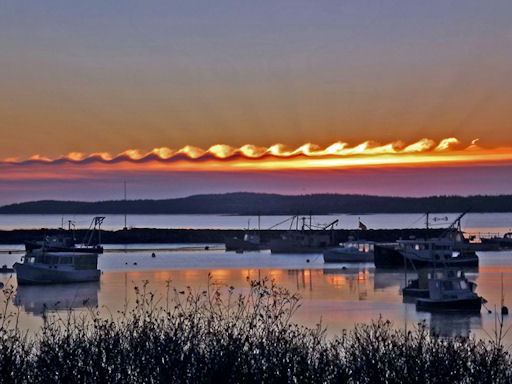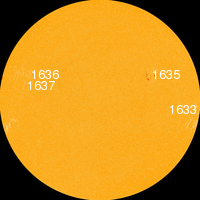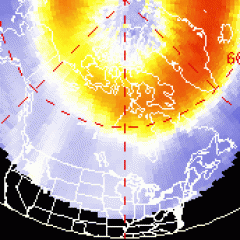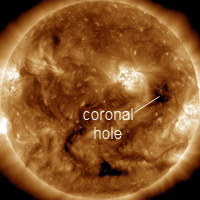SLIM CHANCE OF FLARES: Sunspot AR1635 is crackling with low-level C-class solar flares. There is a slim chance of stronger flares: NOAA forecasters put the odds of an M-class eruption on Dec. 27th at 5%. Overall, solar activity is very low and is likely to remain so for the rest of the week. Solar flare alerts: text, voice.
VAN GOGH CLOUDS: On Christmas morning, Gene Hart of Jonesport, Maine, woke up early to enjoy the sunrise before opening presents. What he saw may have been the best gift of all. "There was a cloud formation showing a remarkable series of wave shapes," says Hart. "They were backlit by the rising sun over Moosabec Reach." He snapped this picture of the harbor using a 14-megapixel digital camera:
"I also took some 28x zoom images of the wave structure," says Hart. The close-ups are a must-see.
These clouds, sometimes called "billow clouds," are produced by the Kelvin-Helmholtz instability when horizontal layers of air brush by one another at different velocities. A better name might be van Gogh clouds: It is widely believed that these waves in the sky inspired the swirls in van Gogh's masterpiece The Starry Night.

![]()
Solar wind
speed: 293.0 km/sec
density: 1.8 protons/cm3
explanation | more data
Updated: Today at 2217 UT
![]()
X-ray Solar Flares
6-hr max: B4 2143 UT Dec27
24-hr: C1 0224 UT Dec27
explanation | more data
Updated: Today at: 2200 UT
![]()
![]()
![]()
Daily Sun: 27 Dec 12
![]()
![]()
Sunspot 1635 is crackling with low-level C-class solar flares. Credit: SDO/HMI
![]()
![]()
![]()
Sunspot number: 82
What is the sunspot number?
Updated 27 Dec 2012
Spotless Days
Current Stretch: 0 days
2012 total: 0 days (0%)
2011 total: 2 days (<1%)
2010 total: 51 days (14%)
2009 total: 260 days (71%)
Since 2004: 821 days
Typical Solar Min: 486 days
Update 27 Dec 2012
The Radio Sun
10.7 cm flux: 110 sfu
explanation | more data
Updated 27 Dec 2012
![]()
![]()
![]()
Current Auroral Oval:
![]()
Switch to: Europe, USA, New Zealand, Antarctica
Credit: NOAA/POES
![]()
![]()
![]()
Planetary K-index
Now: Kp= 0 quiet
24-hr max: Kp= 0 quiet
explanation | more data
![]()
Interplanetary Mag. Field
Btotal: 3.5 nT
Bz: 1.7 nT south
explanation | more data
Updated: Today at 2216 UT
![]()
![]()
![]()
Coronal Holes: 26 Dec 12
![]()
![]()
Solar wind flowing from this coronal hole should reach Earth on Dec. 28. Credit: SDO/AIA.





